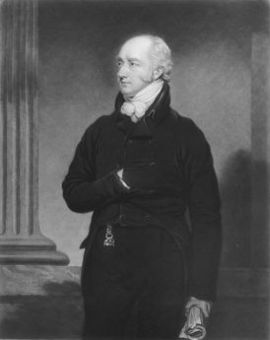British intervention in Spanish American independence facts for kids
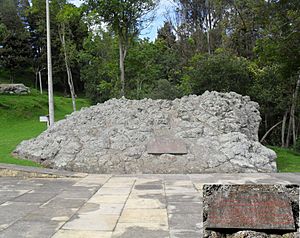
Monument to the British Legions who fought at the Battle of Boyaca on August 7, 1819
|
|
| Date | 1815–1819 |
|---|---|
| Location | United Kingdom of Great Britain and Ireland; Spanish Empire |
| Type | Interventionism |
| Cause | Spanish American wars of independence |
| Motive | Colonialism and Mercantilism |
| Target | Soldiers and sailors recruited in United Kingdom for insurgency. Sales of warships, weapons and ammunition. |
| Participants | British volunteers |
| End of the event | Foreign Enlistment Act of 1819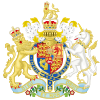 |
Britain played a big part in the Spanish American wars of independence. This included military help, political actions, and diplomatic moves. British merchants and regular citizens also got involved. Britain wanted to see Spain's control over its American colonies end. But they also wanted Spain to remain an ally in Europe after the Napoleonic Wars.
So, British support for the South American revolutionaries was often secret. It involved both private people and the government. British merchants hoped to break Spain's trade control. They sent weapons, supplies, money, ships, and even hired soldiers and sailors to help the rebels. The Royal Navy controlled the seas, which made it hard for Spain to send aid to its colonies. All these things together helped the South American countries gain their freedom.
Contents
Why Britain Helped South America
The fight for independence in Spanish America happened when many powerful countries were competing. These included Spain, the United States, France, and the United Kingdom. Spain saw Britain as its main rival in the Americas. The end of the Napoleonic Wars in Europe changed how these countries allied with each other.
Early British Actions in South America
Between 1806 and 1807, Britain invaded the River Plate area in South America. This region was still part of Spain. The first invasion had about 1,700 soldiers. A second invasion followed with 14,000 men, 20 warships, and 90 transport ships. British forces first took Buenos Aires and then Montevideo. But Spanish colonial armies defeated them. These victories, won with little help from Spain, made people in the River Plate area more unhappy with Spanish rule. George Canning, a key British official, became very involved in the affairs of Spain, Portugal, and Latin America.
Napoleon's Impact on Spain
On May 2, 1808, Napoleon Bonaparte's army entered Spain. This started the Peninsular War. It changed the alliances between European powers. King Ferdinand VII was held in Bayonne. Joseph Bonaparte, Napoleon's brother, took the Spanish throne. This broke the old alliance between France and Spain. Britain then prepared to fight Napoleon's forces in Spain. Spain's navy was weak after the Battle of Trafalgar. This meant Spain had few ships to connect with its colonies overseas.
A weak Spain, busy with war at home and cut off from its colonies, led to rebellions there. South American rebels did not want to be ruled by Napoleonic Spain. Britain used this chance to help its own trade interests. After Ferdinand VII returned to power in 1813, he ignored the help Britain gave Spain during the war. This made Britain more open to South American independence.
Britain's Secret Military Support
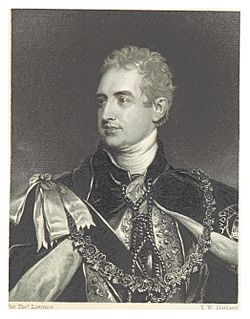
Britain officially said it was neutral in the conflict. This was the policy of Lord Castlereagh's government. Britain wanted to keep Spain separate from France after Napoleon. They feared this would upset the balance of power in Europe. Britain also wanted to protect its own trade interests around the world.
So, Britain did not officially recognize the independence of the revolutionary governments. But they offered military and financial help that was allowed under British law. Britain also refused to agree with Spain that Spain would keep its South American lands. This was partly because Britain wanted to control the new markets in South America.
Breaking Neutrality Rules
In 1817, Britain began recruiting soldiers for the revolutionary forces in South America. For the next two years, the British government faced complaints from Spain. Spain was upset about the large number of British officers, sailors, and soldiers joining the rebels. London knew that the British public supported the rebel cause. This also helped solve a problem: about 500,000 British, Irish, and German soldiers were unemployed after Napoleon's defeat. Many of these war veterans found new jobs fighting in South America.
However, Britain's actions went against its declared neutrality. Many British fighters left the United Kingdom and its colonies to fight Spain. Before 1817, a few British fighters had joined early battles. But the organized recruitment for Simón Bolívar began in April 1817. Venezuelan agents and adventurers like Gregor MacGregor helped recruit British officers and sergeants. They formed their own regiments.
Spain protested this breach of neutrality. The Foreign Office denied any illegal acts. Castlereagh tried to downplay the issue. He said these were isolated cases. Many active officers asked for permission to go to South America. The commander of the army, the Duke of York, had doubts. But Castlereagh allowed it. He said old laws against serving foreign states did not apply to unrecognized states like those in South America. King Ferdinand VII's refusal to make any deals with the revolutionaries actually helped Britain. It made the British government more supportive of South American independence.
By September, recruitment was public knowledge. Newspapers reported details of troops and war supplies heading to South America. The Spanish ambassador protested more strongly. Castlereagh refused to ban enlistment in Britain. He said this would be unpopular with the British public. He also said it would prevent Britain from mediating and trading freely with the Spanish colonies.
Arms Trade and New Ideas
After 1815, things changed a lot. With the war in Europe over, revolutionaries got weapons and ammunition from Britain and its colonies. This helped them create and equip new armies. Britain controlled the seas completely. Its colonies in the Caribbean, like Jamaica and Trinidad, made arms trafficking easy. Britain had many leftover weapons from the Napoleonic War, so they were cheap and available.
British merchants in the Caribbean and Europe gave loans and supplies. This helped the South American revolutionaries get what they needed for their campaigns. As a result, British merchants broke the trade control held by the Spanish elite. More merchants meant new ideas and people from Europe arrived. These included scholars, artists, and skilled workers. With more Europeans across South America, Britain's goal to increase trade helped a whole continent fight for freedom.
| Type of weapon | Quantity |
|---|---|
| Muskets |
704,104 |
Pistols |
100,637 |
Gunflints |
35,617,864 |
Musket balls |
4,508 tons |
Cannonballs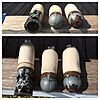 |
10,254 tons |
Sabres |
209,864 |
British Soldiers in South America
From 1817, people were recruited in the United Kingdom to fight in South America. Many were veterans of the Napoleonic Wars. They left Britain to fight for Bolívar. The British Legions were made of the 1st British Legion, the 2nd British Legion, and the Irish Legion. They formed infantry battalions like Albion and Carabobo. They also had cavalry regiments like the Hussars. Their members also fought in other South American units.
The Legion units used their own flags. The English used the Union Flag. The Irish Legion used a green flag with the clàrsach, a symbol of Ireland.
The British Legions became a very important part of Bolívar's army. They played a key role in the Battle of Vargas Swamp in July 1819. Bolívar gave them credit for the victory at the Battle of Boyacá on August 7, 1819. He said, "those soldier-liberators are the men who deserve these laurels." He gave the entire unit the ‘Order of the Liberator’. This was rare during the war. At the Battle of Carabobo, Thomas Ildeston Farriar, leading the British rifles, helped the rebels win. Bolívar called the Legions "the saviors of my country." As a reward, they received the Carabobo battle honor. Bolívar himself gave all their personnel the Liberators' Star.
After Colombia and Venezuela gained independence, the Legions marched across the Andes. They fought at the Battle of Pichincha in May 1822. This battle secured independence for Ecuador. They also took part in the last major campaign of the wars in 1824. This ended with the battles of Junín and Ayacucho in Peru. These battles marked the end of Spanish rule in South America. The British Legions fought until the very end, though their numbers were much smaller. For a long time, their story was largely forgotten.
Other British and Irish soldiers joined Bolívar's forces. Two famous officers were William Miller. His cavalry led the important charge at the Battle of Junín in 1824. Another was Francis Burdett O'Connor, who became chief of staff to Antonio José de Sucre.
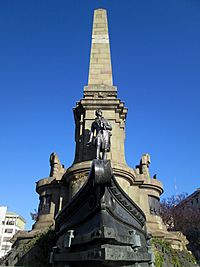
After the Napoleonic Wars, the British Royal Navy had many warships. Most of these ships were sold off. About 250 warships became available to the rebel governments. These ships carried the most modern weapons. Many British sailors and captains also joined these ships in South America. One such captain was John Illingworth. He commanded the Rosa de los Andes. This ship was hired by Chile's revolutionary government.
The most famous Royal Navy sailor of that time was Scotsman Lord Thomas Cochrane. He arrived in Chile in 1818. When Cochrane took command of the Chilean fleet, he replaced most Chilean sailors. He put British or North American officers in charge. The squadron then followed British laws and only English was spoken.
Cochrane worked with Chilean leader Bernardo O'Higgins. Cochrane and his fleet blocked and raided the coasts of Chile. He had done this successfully against France and Spain before.
Cochrane's greatest success was the capture of the forts of Valdivia on February 4, 1820. This effectively ended the last Spanish power in mainland Chile. A huge amount of military goods were captured.
Under General José de San Martín's orders, Cochrane blocked the coast of Peru. This supported the independence campaign there. He transported the Liberation Army from Valparaíso. They landed near Lima, which was freed the next year. On November 5, Cochrane captured the Spanish frigate Esmeralda. This was the most powerful Spanish ship in South America. It was in the port of Callao. The ship was renamed Valdivia for the Chilean Navy.
Cochrane then tried to find other Spanish ships. After chasing them for five months, he blocked them in the port of Guayaquil. They surrendered to the port authorities. Cochrane then left Chilean service in November 1822.
British Diplomacy and New Laws
The Foreign Enlistment Act of 1819
Spain put diplomatic pressure on Britain. Castlereagh based his actions on existing British law. This law said he could only take action against people who served abroad for a recognized prince, state, or ruler. Prosecutors did not think the revolutionaries fit these categories. They were not recognized states. The Lord Chancellor agreed. He said rebel governments could only be seen as sovereign by British courts if the British government recognized them.
For Castlereagh, this created a problem. It made Britain's neutrality impossible. He could not recognize independence too early, nor could he accuse Britons of helping rebels. So, he concluded a new law was needed. But he delayed it. It was not good to discuss it publicly in 1818, while the war was still ongoing.
By 1817 and 1818, the war was going well for the rebel governments. Finally, a new law was presented to parliament on May 13, 1819. This law aimed to stop people from joining foreign service or equipping ships for military purposes without permission. By this time, about 10,000 people from the British Isles had served in South America. Around 6,500 had served in armies and 3,500 in navies. The law also included rules for trials and seizing ships carrying recruits or weapons. Despite the law being passed, there was no real plan to enforce it.
The Spanish ambassador believed the law was just for show. Castlereagh's biggest success was making a deal with European powers. This happened at the Congress of Aix-La-Chapelle and the Congress of Verona four years later. Both meetings meant that no military force other than Spain's would be sent to South America. This stopped aid to Spain. It prevented Spain from taking back its colonies. With the Royal Navy controlling the oceans, this was a key factor in the independence of Latin American countries.
George Canning's Role
George Canning took over from Castlereagh as Foreign Secretary. He continued Castlereagh's goals. Canning wanted to ensure Spanish colonialism ended. He also wanted the newly independent Latin American countries to open up for trade. He also wanted to prevent France from gaining influence in the region. He was very successful. He oversaw the independence of South and Central America. This supported the Monroe Doctrine and helped British merchants find new markets.
What Happened Next
In November 1825, the first minister from a Latin American state, Colombia, was officially welcomed in London. By 1826, it was clear that Britain was a major influence in how Latin America related to the rest of the world.
Britain had managed to keep Spain as an ally for European matters. At the same time, British involvement between 1815 and 1819 was a key reason for the independence of South American states. Especially important was the rearming of the revolutionary armies. The British Legions played a big role in Bolívar's campaigns. Lord Cochrane's squadron was crucial in Chile's naval campaign.
British influence was strong enough to stop Spain from trying to regain control of its lost colonies. After this, Britain remained the most important trading partner for all Latin American countries. They supplied many goods like textiles. They also offered a market free of import duties after the 1840s.
Legacy
In 1926, the Pan-American Centennial Conference took place in Panama City.
See also
 In Spanish: Intervención británica en la independencia hispanoamericana para niños
In Spanish: Intervención británica en la independencia hispanoamericana para niños



